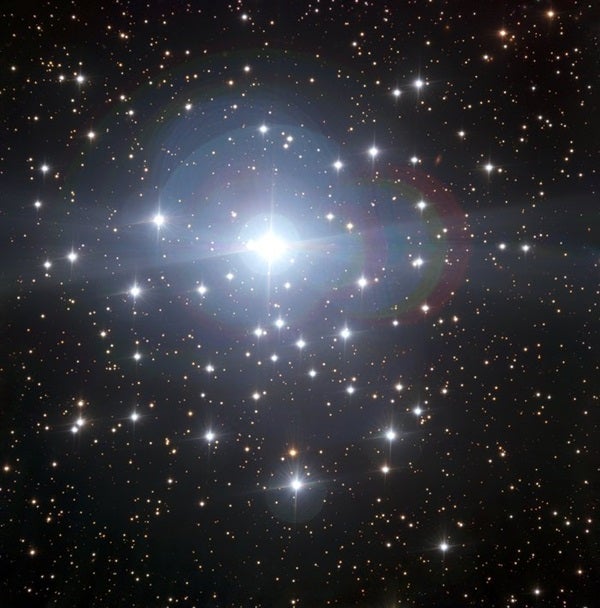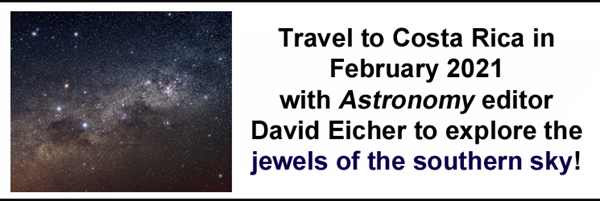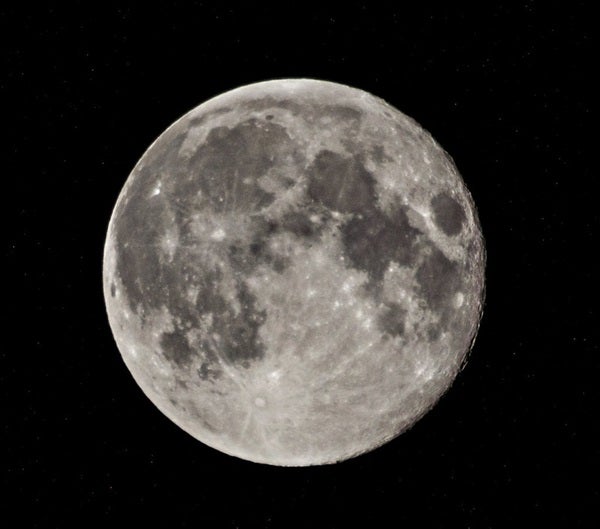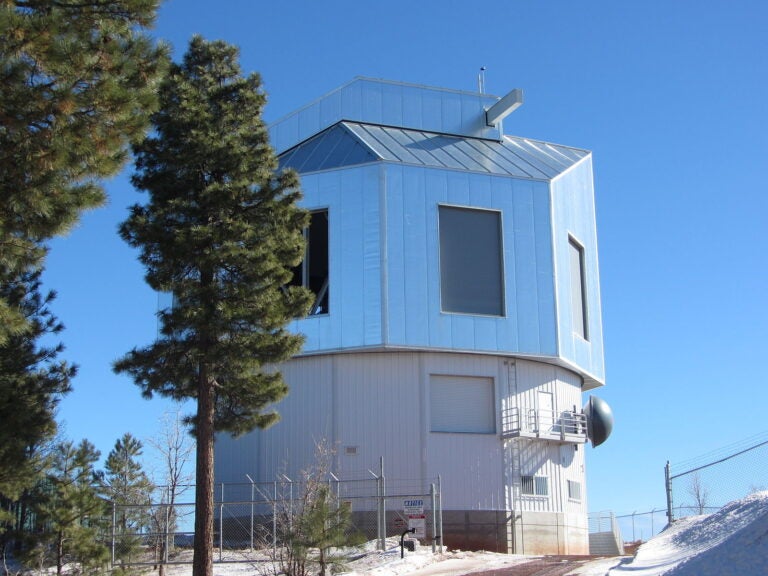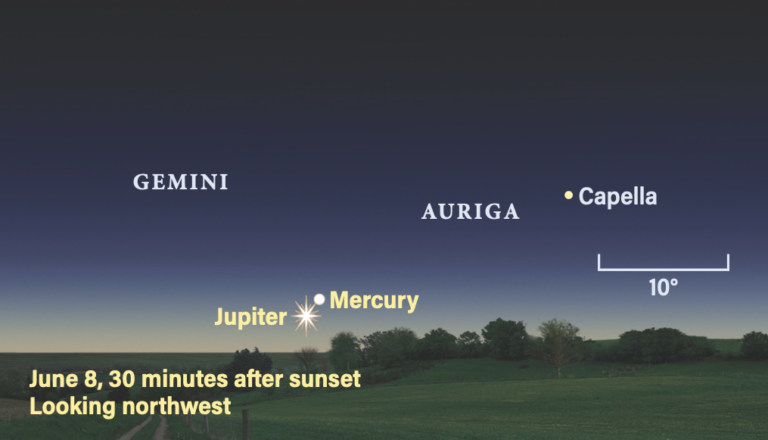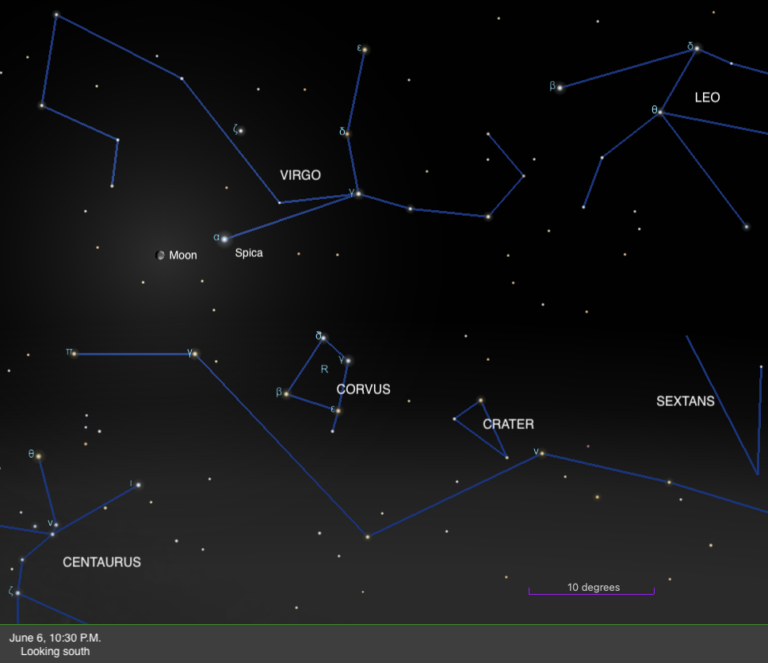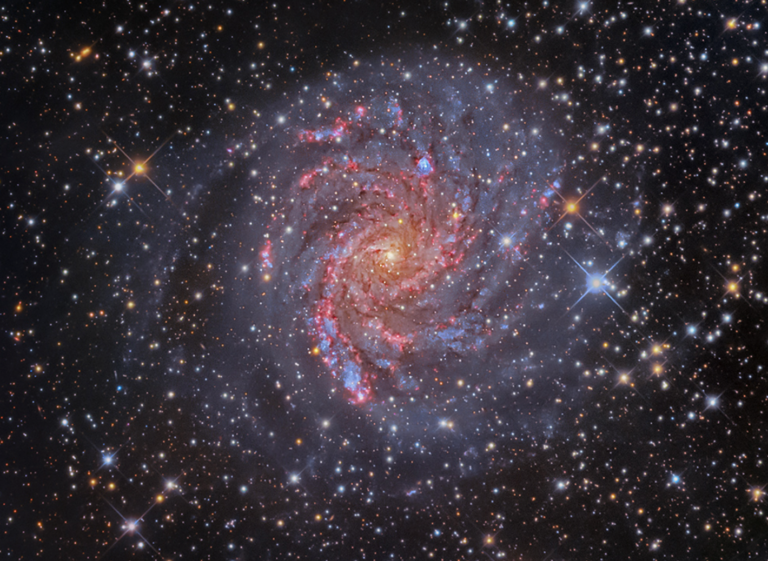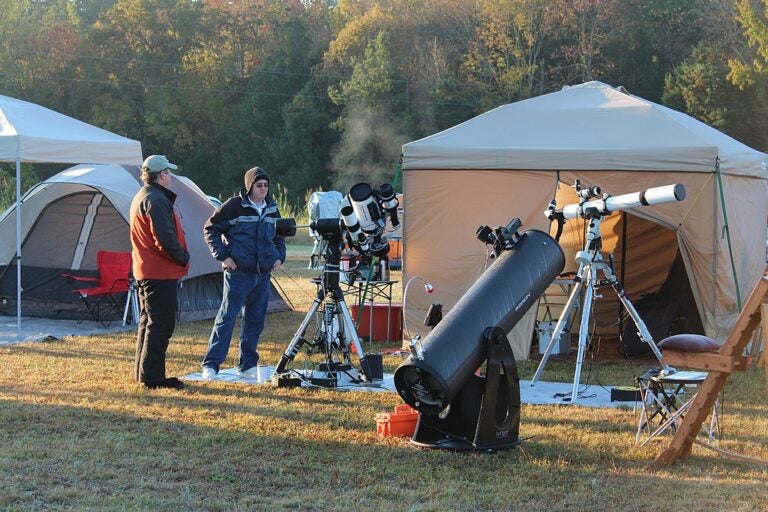The Red Planet is easy to spot tonight from its perch high in Aries to the south after dark. With a large telescope or video capture capabilities, you may be able to make out features on its 8″-wide disk. The dark Syrtis Major and the large, circular Hellas basin feature centrally on the martian disk around 9 P.M. EST. Keep revisiting the Red Planet as the week progresses — the Moon will remain bright but peel away from the region, offering slightly better contrast with the dark background sky.
Just 2° southwest of Mars is the ice giant Uranus. At nearly magnitude 6 and with that bright Moon nearby — just over the border in Taurus — you’ll need at least binoculars to make it out. Look for a grayish “flat” star about half the size of Mars; of course, Uranus is physically much larger, but it sits nearly 20 times farther from Earth than the Red Planet, diminishing its size. Again, revisit this region in the coming days, but know that Uranus will remain a bit harder to find until the Moon’s light is no longer an issue.
Sunrise*: 7:16 A.M.
Sunset: 5:08 P.M.
Moonrise: 12:20 P.M.
Moonset: 1:49 A.M.
Moon Phase: Waxing gibbous (67%)
*Times for sunrise, sunset, moonrise, and moonset are given in local time from 40° N 90° W. The Moon’s illumination is given at 12 P.M. local time from the same location.
Asteroid 4 Vesta is stationary at 5 P.M. EST. The second-most massive object in the main asteroid belt, Vesta currently shines at magnitude 6.8 in the hindquarters of Leo the Lion. It rises around 9 P.M. EST, but wait an hour or two for the region to climb away from the more turbulent air near the horizon. By 10 or 11 P.M., pull out your binoculars to find Vesta just over 4° southwest of Denebola, which marks the tip of the Lion’s tail.
Mercury is at greatest eastern elongation (19°) at 9 P.M. EST — its second best of the year for those observing from the Northern Hemisphere. (The best is yet to come: it’ll happen in May.) Tonight, the solar system’s smallest planet sets about 90 minutes after the Sun and is a bright magnitude –06. Just 2.8° to the planet’s left (southeast) and matching it in altitude is the magnitude 2.9 star Denenb Algedi.
Through a telescope, you’ll see that Mercury’s disk is just 56 percent lit and spans roughly 7″. If you come back for another look tomorrow, Mercury will appear almost exactly half lit.
Finally, Saturn is in conjunction with the Sun at 10 P.M. EST, rendering it invisible. It will reappear in the morning sky around the second week of February.
Sunrise: 7:16 A.M.
Sunset: 5:09 P.M.
Moonrise: 12:52 P.M.
Moonset: 2:48 A.M.
Moon Phase: Waxing gibbous (76%)
Sunday, January 24
Asteroid 14 Irene reaches opposition at 12 P.M. EST. It’s rising in Cancer the Crab as the Sun sets, so any time after darkness falls is perfect to seek out the small world. You’ll find it glowing at magnitude 9.4 (a perfect binocular object) less that 2° due west of Iota (ι) Cancri, a fourth-magnitude star in the northern part of the constellation.
Once you’ve viewed Irene, glance southeast and you can’t miss your next target: brightly glowing Procyon in Canis Minor. Although not as bright as its counterpart in Canis Major, Procyon is still easy to find at magnitude 0.4. This class F star weighs as much as one and a half Suns, but shines seven times more powerfully than our star. Like the Dog Star in the bigger of Orion’s two hunting dogs, Procyon also hosts a white dwarf companion — the tiny, dim remnant of a Sun-like star. This stellar ember, dubbed Procyon B, glows a feeble magnitude 10.8 and sits within 5′ of Procyon A (the brighter star), making it a real challenge to observe — perhaps the reason it wasn’t visually confirmed until 1896.
Sunrise: 7:15 A.M.
Sunset: 5:10 P.M.
Moonrise: 1:29 P.M.
Moonset: 3:49 A.M.
Moon Phase: Waxing gibbous (84%)
Roughly two hours before sunrise, the Moon has finally set and Gemini the Twins are standing upright on the western horizon. The Twins’ heads, Castor (which appears on the right) and Pollux (left), shine brightly about 20° high.
They’re roughly the same magnitude (Pollux is a few tenths of a magnitude brighter) but through binoculars or a telescope, you may notice they’re slightly different colors: Castor appears blue-white, while Pollux is a bit more orange-hued. That’s because Castor is a hot type A star, while Pollux is a type K star and slightly cooler than the Sun.
But Castor has another advantage over Pollux: sheer numbers. A small telescope will reveal that Castor appears to be not one, but two stars about 4″ apart. Called Castor A and B, both are type A stars. However, the Castor family is larger, still — Castor C, which is visible about 70″ from A, is a cooler, dimmer type M star orbiting A and B together.
Each of these three stars is also a binary, bringing the total number of stars in the Castor system to six.
Sunrise: 7:14 A.M.
Sunset: 5:11 P.M.
Moonrise: 2:12 P.M.
Moonset: 4:49 A.M.
Moon Phase: Waxing gibbous (90%)
Tuesday, January 26
A few days ago, we visited Canis Minor. Tonight, let’s visit Canis Major, which has cleared the horizon by two hours after sunset. Wait a little longer, and it will rise even higher in the sky.
Again, the bright Moon is nearby, but tonight we’re seeking out a bright open cluster, NGC 2362, also called the Tau Canis Majoris Cluster after its brightest star: Fourth-magnitude Tau (τ) Canis Majoris. This star dominates the cluster’s light; you’ll need to train binoculars or a small scope on the region to see any of its neighbors. Look about 2.8° east-northeast of Wezen (Delta [δ] Canis Majoris), which marks the top of the Big Dog’s hindquarters, to find the cluster. It covers roughly 8′ of sky, although some stars may be hard to spot with the Moon’s brighter background light. (So keep this target in mind and plan to return once the Moon’s phase has progressed.)
Tau itself is sometimes called the Mexican Jumping Star, possibly because it always remains relatively low in the sky. That, coupled with its relative brightness, makes it particularly susceptible to scintillation, which occurs when starlight is viewed through Earth’s turbulent atmosphere. This can cause a star to change apparent brightness and even color quite rapidly, sometimes looking as if you’re viewing it through a kaleidoscope. Sirius, the Dog Star, is also subject to this effect when it’s low on the horizon.
Compare the two now — Sirius is roughly 11° higher in the sky, climbing away from the turbulent horizon air more quickly, and so may be twinkling less.
Sunrise: 7:13 A.M.
Sunset: 5: 13 P.M.
Moonrise: 3:05 P.M.
Moonset: 5:46 P.M.
Moon Phase: Waxing gibbous (95%)
Wednesday, January 27
With a nearly Full Moon in Cancer tonight, only bright stars are easily visible. After sunset, test your eyesight in Taurus the Bull, who hosts the famous Pleiades star cluster, also cataloged as M45. Most observers can see six or seven stars with the unaided eye, and that might be the most you’ll see tonight. But come back in several days on a darker night and you may see as many as 11 stars without optical aid, depending on the quality of your eyesight.
The Pleiades is a young open cluster of stars estimated at just a few tens of millions of years in age. Look to their southeast and you’ll find another open cluster of stars making the “v” of the Bull’s face: the Hyades, one of the closest open star clusters to Earth. Among them shines bright Aldebaran, the eye of the Bull, although this star is not actually part of the cluster. It’s also moving in a different direction on the sky than the cluster, meaning Taurus’ v-shaped visage will eventually start to deform over the next several tens of thousands of years.
Keep following a line drawn between the Pleiades and Hyades, and eventually you’ll reach Betelgeuse, the famous red giant star marking the shoulder of Orion the Hunter. This star became recently famous as it underwent a strange dimming event that astronomers attribute to a “stellar sneeze,” in which the star blew out a cool cloud of dust, temporarily blocking some of its light. It’s now back to its original brightness.
Sunrise: 7:13 A.M.
Sunset: 5:14 P.M.
Moonrise: 4:04 P.M.
Moonset: 6:38 A.M.
Moon Phase: Waxing gibbous (99%)
Full Moon occurs at 2:16 P.M. EST; the traditional name for the January Full Moon is the Wolf Moon.
During Full Moon, our satellite rises just as the Sun is sinking below the horizon and remains visible all night. Aside from bright stars and planets, the Moon is likely the only thing you’ll be able to observe, so let’s zoom in on some of the features visible during this phase.
While the entire nearside of the Moon is on display at this time, it’s also directly illuminated by the Sun, which can wash out certain details. Some of the best spots to focus on during Full Moon include the craters Copernicus and its neighbor Kepler. Copernicus is located in Oceanus Procellarum on the left side of the Moon (when viewed unaided); Kepler is a bit farther to Copernicus’ lower left.
The huge crater Tycho is also hard to miss, dominating in the southern region of the Moon with long, bright streaks stretching away from it. These streaks, which also appear around Copernicus and Kepler, are rays of ejecta — material that was thrown up from the surface of the Moon when these features were created, flying as far as 750 to 1,200 miles (1,200 to 1,900 kilometers) from their point of origin.
Following in the footsteps of its fellow gas giant earlier this week, Jupiter is in conjunction with the Sun at 9 P.M. EST. It, too, will be visible in the early morning by mid-February.
Sunrise: 7:12 A.M.
Sunset: 5:15 P.M.
Moonrise: 5:11 P.M.
Moonset: 7:25 A.M.
Moon Phase: Full
Friday, January 29
Rising only 30 minutes before the Sun, Venus makes for a challenging morning target in the eastern sky. Still, it’s bright at magnitude –3.9, increasing your chances of spotting it. If you can catch it through binoculars or a telescope, you’ll see its disk is roughly 10″ across and nearly full (97% lit). Do take care when following it in the brightening sky, however — set an alarm for several minutes before local sunrise and call an end to using any optical aid at that time. This will eliminate the chance of accidentally swinging your optics toward the Sun after it’s risen, which can cause severe and permanent eye damage.
Venus’ fellow inferior planet, Mercury, is stationary against the background stars at 9 P.M. EST this evening. Before today, it was tracking northeast; now it will make a U-turn and head southwest. Tonight, you can follow this speedy planet in the west for more than an hour after sunset.
Sunrise: 7:11 A.M.
Sunset: 5:16 P.M.
Moonrise: 6:20 P.M.
Moonset: 8:05 A.M.
Moon Phase: Waning gibbous (99%)

